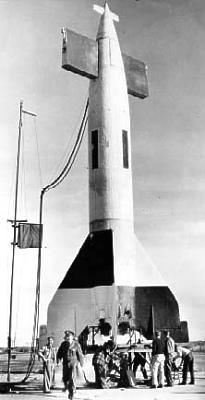
Home - Search - Browse - Alphabetic Index: 0- 1- 2- 3- 4- 5- 6- 7- 8- 9
A- B- C- D- E- F- G- H- I- J- K- L- M- N- O- P- Q- R- S- T- U- V- W- X- Y- Z
Hermes A-3
 Hermes B-1 |
AKA: Hermes A-3A;RV-A-8;SSM-G-8. Status: Retired 1954. First Launch: 1953-03-13. Last Launch: 1954-01-15. Thrust: 80.00 kN (17,984 lbf). Gross mass: 3,780 kg (8,330 lb). Height: 8.70 m (28.50 ft). Diameter: 1.02 m (3.34 ft). Span: 2.29 m (7.51 ft). Apogee: 30 km (18 mi).
Development began in 1947 of the Hermes A-3, a liquid-propellant surface-to-surface missile with a payload of 450 kg (1,000 lb), range of 240 km (150 miles), and a CEP of 60 m (200 ft). The performance was little different from the German V-2, but the accuracy was much better due to the decision to equip the missile with an inertial navigation system. Development was slow. In 1951 it was decided to have a phased approach, with the Hermes A-3A interim test vehicle to lead to the Hermes A-3B operational missile with a 47 kT W-5 nuclear warhead.
Between March 1953 and January 1954 seven Hermes A-3As were launched, five of them failures. The Hermes A-3 program was reduced to a pure research effort in June 1953. Six Hermes A-3B's were launched between May and November 1954, five of them failures. Hermes was cancelled the same year and the development of a missile to this requirement was assigned to von Braun's team, emerging as the Redstone a few years later.
Maximum range: 105 km (65 mi). Boost Propulsion: Liquid propellant.
Historical Essay © Andreas Parsch
In late 1947, the U.S. Army established preliminary characteristics for the Hermes A-3 program, calling for a liquid-fueled rocket-powered surface-to-surface missile to carry a 450 kg (1000 lb) warhead to 240 km (150 miles) with an accuracy of 60 m (200 ft) CEP. In early 1948, the designation SSM-G-8 was assigned, but the project progressed very slowly in the first years. This was mainly because of frequent changes in the requirements, which repeatedly necessitated a complete redesign of the projected XSSM-G-8 missile. However, the Hermes A-3 program accelerated somewhat in 1951, when it was split into the RV-A-8 Hermes A-3A interim test vehicle and the SSM-A-16 (briefly SSM-G-16) Hermes A-3B operational missile with a W-5 nuclear warhead (47 kT).
The first flight attempt of an RV-A-8 failed in March 1953, but the second test succeeded in June that year. Until January 1954, a total of seven Hermes A-3As were launched, but only two flights were fully successful. Nevertheless, the RV-A-8's reliable (for its time) high-performace liquid-fueled rocket engine and its inertial guidance system significantly advanced the state-of-the-art in ballistic missile design. Although the Hermes A-3 program was reduced to a pure research effort in June 1953, six XSSM-A-16 Hermes A-3B missiles were launched between May and November 1954. However, only one of these (in October) was fully successful. The XSSM-A-16, originally designed as the prototype for the operational missile, was of similar design but slightly larger than the RV-A-8, and featured a further improved radio-inertial guidance system.
The Hermes A-3B was actually the last surviving element of the Hermes program, and the latter was finally terminated at the end of 1954. Although Hermes did not result in any operational missile, the Army's successful SSM-A-14-PGM-11 Redstone and SSM-A-27-MGM-29 Sergeant missiles owed much to the technology studied and tested during the Hermes program.
Family: tactical ballistic. Country: USA. Agency: GE.
Back to top of page
Home - Search - Browse - Alphabetic Index: 0- 1- 2- 3- 4- 5- 6- 7- 8- 9
A- B- C- D- E- F- G- H- I- J- K- L- M- N- O- P- Q- R- S- T- U- V- W- X- Y- Z
© 1997-2019 Mark Wade - Contact
© / Conditions for Use